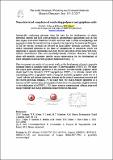Por favor, use este identificador para citar o enlazar a este item:
http://hdl.handle.net/10261/215395COMPARTIR / EXPORTAR:
 SHARE
BASE SHARE
BASE
|
|
| Visualizar otros formatos: MARC | Dublin Core | RDF | ORE | MODS | METS | DIDL | DATACITE | |

| Título: | Nanostructured complexes of conducting polymers and graphene oxide |
Autor: | Istif, Emin CSIC ORCID; Vallan, Lorenzo CSIC ORCID; Benito, Ana M. CSIC ORCID ; Maser, Wolfgang K. CSIC ORCID | Palabras clave: | Graphene oxide Poli(3-hexylthiophene) Nanostructures |
Fecha de publicación: | 13-sep-2017 | Citación: | 9th Nanodays Workshop on Advanced Materials (2017) | Resumen: | Intrinsically conducting polymers form the base for the development of plastic electronic devices and hold great promise in optoelectronic applications such as thin film organic field-effect transitors, OLEDS and solar cells. Control of morphology and aggregation states by nanostructuring is essential for improving the device performance. In the last decade, research has focused on liquid phase assembly processes. These afford conjugated polymers in the form of nanoparticles or nanowires, which are dispersible in aqueous dispersions and allow for the fabrication of thin films with well-defined characteristics from environmentally-friendly solutions. Moreover, the liquid phase self-assembly processes provide unique opportunities for the development of novel composite materials with graphene based materials [1, 2]. Here we present our results of our recent work on the development of novel composite materials based of graphene oxide and poly (3-hexylthiophene) (P3HT) [3]. We show that liquid phase assembly processes in the presence of water-soluble graphene oxide sheets lead to the formation P3HT nanoparticles (P3HTNPs) in intimate contact with surrounding sheets of graphene oxide. During the synthesis, graphene oxide acts as a >good> solvent and induces important changes on the internal aggregation structure and the related interchain coupling. At the same time, the charge-transfer properties as a function of GO concentration are modified. Both effects are intimately coupled and lead to the stabilization of of P3HTNPs-GO donor-acceptor nanostructures offering improved charge transport and charge separation characteristics in thin films. | Descripción: | 1 figure.-- Talk delivered at the 9th Nanodays Workshop on Advanced Materials, Munich (Germany), Sept. 13-15, 2017 | URI: | http://hdl.handle.net/10261/215395 |
| Aparece en las colecciones: | (ICB) Comunicaciones congresos |
Ficheros en este ítem:
| Fichero | Descripción | Tamaño | Formato | |
|---|---|---|---|---|
| Nanostructured complexes_2017_Istif et al.pdf | 252,03 kB | Adobe PDF |  Visualizar/Abrir |
CORE Recommender
Page view(s)
108
checked on 22-abr-2024
Download(s)
40
checked on 22-abr-2024
Google ScholarTM
Check
NOTA: Los ítems de Digital.CSIC están protegidos por copyright, con todos los derechos reservados, a menos que se indique lo contrario.
